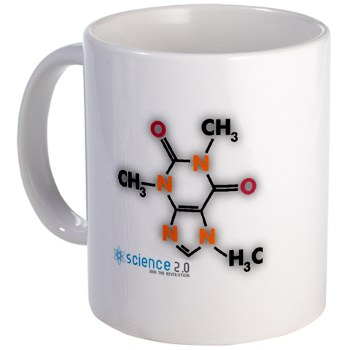With the volume of science done in coffee houses (like Newton, who ate his meals in one every day) you'd think that anything about coffee, including coffee rings left behind from spillage, would be studied to death.
Not really. In 1997, Robert Deegan and colleagues showed that the coffee ring pattern was due to capillary flow induced by the differential evaporation rates across the drop (1) but since then little has been done. Sometimes science is practical instead of informational and 'just use a coaster' is enough.

Subliminal advertising meets applied physics. The perfect gift this holiday season.
But if you have the scanning electron microscope and the time to write a numerical model, coffee science is too good to resist, and so Shreyas Mandre of Brown University, Ning Wu from Colorado School of Mines and L. Mahadevan and Joanna Aizenberg from Harvard University have devised a predictive model that combines laboratory studies of microscopic glass particles in solution with mathematical theories to predict the existence, thickness and length of the banded ring patterns that formed.
They presented their results at the APS Division of Fluid Dynamics meeting in Long Beach, CA, suggest the patterned deposition of particles can be controlled by altering physical parameters such as evaporation and surface tension and perhaps one day manipulated to create small-particle tools.
The team found that during ring deposition, a particle layer of uniform thickness is deposited if the concentration is above a certain threshold. Below that threshold the deposits form non-uniform bands. The threshold is formed because evaporation at the solid-liquid interface of the rim occurs faster than a replenishing flow of water from the center of the droplet can replace the evaporating rim fluid. This leaves the particles on the rim high, dry and deposited.
Exploiting this competition between evaporation and replenishment is the key to controlling the process as a microtool. Potential applications include printing, making industrial coatings, fabricating electronics, and designing new medicines.
"Controlling the ring deposition process would be useful for creating such things as new microphysics tools operating at a scale where pliers or other traditional tools for moving particles cannot operate," said Mandre.
NOTE:
(1) R. D. Deegan, O. Bakajin, T. F. Dupont, G. Huber, S. R. Nagel, T. A. Witten, 'Capillary flow as the cause of ring stains from dried liquid drops', Nature 389 (1997) 827–829. doi:10.1038/39827





Comments